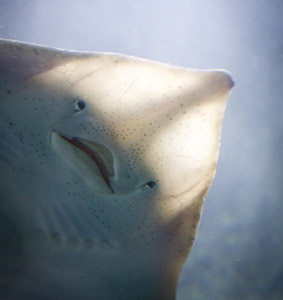With the holidays officially upon us, itís time to embark in wintery festivities. Whether you plan to sip on hot cocoa or spiced cider, or check out the decorations in Union Square or at PIER 39, there are plenty of ways to get into the holiday spirit.

A skateís mouth can be found on the underside of its body, along with five gill slits. Photo courtesy of Aquarium of the Bay
By Mallory Johnson
Published: December, 2014
With the holidays officially upon us, it’s time to embark in wintery festivities. Whether you plan to sip on hot cocoa or spiced cider, or check out the decorations in Union Square or at PIER 39, there are plenty of ways to get into the holiday spirit. A reliable favorite activity is ice skating at Justin Herman Plaza, but did you know that there are skates in the Bay year-round?
Worldwide, there are close to 100 different species of skates, the largest of which is aptly named the big skate. Big skates typically reach about six feet long and up to 200 pounds; the largest big skate on record is nearly eight feet long.
This not-quite-as-well-known cousin of the bat ray has certain similarities to its relative, but has many distinctive characteristics of its own. Like the bat ray, skates are flat fish with large pectoral fins that allow them to gracefully glide through the water. Unlike the bat ray—whose head is raised—the big skate’s head is flattened and its body much more resembles a diamond. Its large pectoral fins, often called wings, are broadly expanded and attach to the head and body. The top of its snout and pectoral fins are finely pointed, resulting in its distinct shape. Skates also boast a slender and whip-like tail that’s almost as long as their bodies. In addition, big skates are equipped with a handy set of thorns that line the back of their bodies and tail as a clever way of thwarting predators.
As a flat fish, both of the big skates eyes are on the dorsal, or upper, side of its body. Skates will frequently hide motionless on the bottom of the ocean with only their eyes protruding from the sand. Meanwhile, a skate’s mouth can be found on the underside of its body, along with five gill slits. Skates intake water through openings called spiracles on the top of their heads and then push it out through their gills, enabling them to breathe while buried in the sand. This respiration method also conveniently helps them stay buried in their preferred locations.
The underside of big skates is a classic white, while on top they don a brown and white speckled pattern, which helps them stay camouflaged along the sandy ocean floor. Big skates also feature two large spots on each of their wings. The big skate’s scientific name is Raja binoculata, which is quite fitting. Binoculata means “two eyes,” referring to the spots on their pectoral fins. These spots are believed to be another clever defense mechanism of the big skate meant to deceive predators into thinking they are actually eyes, tricking them into believing that the skate is a much larger fish than it really is.
Similar to bat rays, a skate’s skeleton is made up of cartilage rather than bone, a characteristic they also share with another distant relative—sharks.
While various species of skates can be found around the world, big skates are typically found along the western coast of North America in estuaries and bays. They tend to live along the sandy seafloor where they feed on a variety of prey that includes shrimps, worms, clams and even some fishes.
You can learn more about big skates, see, and even touch them for yourselves when you visit Aquarium of the Bay this holiday season. Do more than ice skate; join in the fishy festivities and visit www.aquairumofthebay.org.
Mallory Johnson is the Public Relations Coordinator for Aquarium of the Bay, a nonprofit organization dedicated to protecting, restoring and inspiring the conservation of San Francisco Bay and its watershed.

